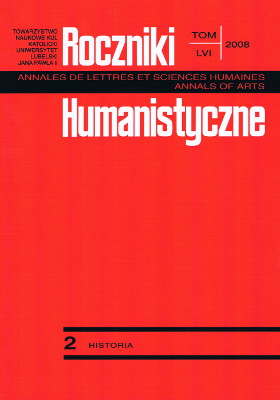John Sobieski The III-rd in Vienne, Chosen Aspects of the Character
Abstract
The aim of the article is to present the chosen aspects of John Sobieski the III-rd reception in the former capital city of Habsburg Monarchy and also to study how much fresh in this city is memory of polish king after 300 years which passed from the time of Viennese battle. The special attention has been concentrated on the following issues: the genesis of origin of remembrances devoted to polish King, studying of its importance in comparison with some other similar objects and possible reception of John III Sobieski character which is based on them. Then there have been compared the reception of polish King and the reception of some other Poles which were connected with the Viennese battle: George Francis Kulczycki, courier and legendary founder of the first Viennese café and Stanislaus Potocki, captain and colonel of cavalry. There have been set together the names of commanders of allied armies with Austria who came not from Austrian territory but who have the streets called their names in this metropolis. The article is completed by the analysis of Vienna book-guides to find the information − how much John III Sobieski is today still present in the Viennese’s memory although he was well-deserved few centuries ago.
References
Abrahamowicz Z., Franciszek Jerzy Kulczycki, w; Polski Słownik Biograficzny, t. XVI, Wrocław; Ossolineum 1971.
Bogdański H., Dziennik Podróży z lat 1826 i 1827, Kraków 1983.
Chełmecki J., König Johann Sobieski und die Befreiung Wiens, Wieden 1883.
von C1ausewitz C., Hinterlassene Werke, t. V, Berlin 1837.
Czeike F., Historisches Lexikon Wien, t. I-VI, Wiedeń 1994-2006.
Gierowski J.A., Rzeczpospolita w dobie złotej wolności (1648-1763), Kraków 2001.
Gubry no w icz A., Pamiątki polskie w Wiedniu i okolicy, „Kurier Warszawski” 1926, nr 216-217.
G u g i t z G., Das Wiener Kaffeehaus, Wiedeń 1914.
Hajdecki A., O wielkości i potędze narodu polskiego w świetle pomników historycznych wiedeńskich. Szkice historiograficzne, Poznań 1929.
Herbaczyński W., W dawnych cukierniach i kawiarniach warszawskich, Warszawa 1988.
K1einde1 W., Die Chronik Österreichs, Wiedeń 1994.
K1uczycki J.F., Pamiątki polskie w Wiedniu i jego okolicach. Jako też inne wiadomości tyczące się Polaków, szczególniej mieszkańców Galicji, Kraków 1835.
Lubomirski E., Obraz historyczno-statystyczny Wiednia oryginalnie 1815 wystawiony z planem tegoż miasta, Warszawa 1821.
Morelowski J., O pamiątkach przeszłości polskiej w Wiedniu, „Wiedeński Kurier Polski” 1915, nr 266-267.
Nadolny A., Polacy na Kahlenbergu, „Studia Pelplińskie” 1982.
Nagielski M., Venimus, Vidimus, Deus vicit. Wiktoria wiedeńska z 1683 roku w relacjach i dokumentach z epoki, Warszawa 1984.
Österreich - Lexikon, http://www.aeiou.at/aeiou.encyclope/.
„Postęp” 1962, nr 28.
Rosco Bogdanowicz M.; Wspomnienia, t. I, Kraków 1959.
Smoliński J., Kahlenberg, Kościół św. Józefa, Wiedeń-Lublin 1998.
Sturminger W., Bibliographie und Ikonographie der Türkenbelagerungen Wiens 1529 und 1683, Graz-Köln 1955.
Taborski R., Polacy w Wiedniu, Wrocław 1992.
Teply K., Die Einführung des Kaffees in Wien, Wiedeń 1980.
Wagner M., Stanisław Potocki, w; Polski Słownik Biograficzny, t. XXVIII, Wrocław; Ossolineum 1984-1985.
Wolfram H., Österreichische Geschichte 1804-1914, Wiedeń 1999.
Copyright (c) 2008 Roczniki Humanistyczne

This work is licensed under a Creative Commons Attribution-NonCommercial-NoDerivatives 4.0 International License.





